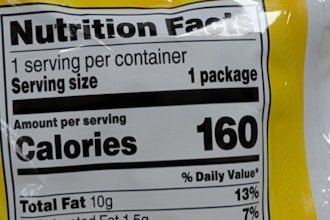
In case you missed it, March was National Nutrition Month. This is an outgrowth of a program that began in the early 1970s to help deliver nutritional messages to the public. While the program has had many successes, it has been an ongoing battle.
Just the fact that obesity is such a problem in the United States is an indication, according to some observers, that either people are not reading nutrition labels — which are designed to provide them with the information they need to make healthy food selections — or they don’t understand them.*
Many in the labeling and food service industries are starting to think it is the latter. We know from research more people are reading food labels. However, many individuals possibly don’t know what the information on those labels means for them.
One of the first studies to verify this was published in 2012. Conducted by Nielsen, a global provider of insights and analytics regarding what consumers buy, the study found the following:
• Nearly 60 percent of all consumers around the world have difficulty understanding nutritional facts found on food labels.
• 52 percent reported they understand the labels “in part.”
• Just over 40 percent indicated they “mostly” understand the labels.
• 7 percent said they do not understand food labels at all.
Note, this was a global study. Compared to people in other parts of the world, North Americans were more apt to understand food labels and the information they are designed to convey. Rural, Asian, Asia Pacific and Southeast Asian countries had the greatest difficulty.
Skepticism
But wait, that’s not the end of the story.
The Nielsen study also found that even those of us who understand food labels (or mostly understand them) have considerable skepticism about the information printed on them. And several studies since 2012 parallel Nielsen’s finding. They all report varying degrees of consumer doubt about the accuracy of information found on food labels.
“Across 10 nutritional content categories studied, at least more than two-thirds of global respondents indicate they believe the nutritional claims are either never or only sometimes trustworthy,” states the Nielsen report.
The claim most trusted on a food label is the calorie count, according to Nielsen and similar reports. Nearly 60 percent indicated they always or almost always trust the amount indicated. This was followed by vitamins/vitamin percentages and fat content claims.
However, here’s the problem and likely the key reason for much of the skepticism: terms such as “freshness,” “heart-healthy,” “100% whole grain,” “rich in” and “healthy” are invariably met with raised eyebrows.
“Consumers have difficulty trusting more ambiguous attributes compared to the concrete ingredient-based information,” said James Russo, vice president, Global Consumer Insights at Nielsen. “Clearly there is a need and an opportunity for more education to help reduce the skepticism that is apparent around all parts of the globe.”
Clarifying Some Terms
It’s important for the food service industry to have a grasp on what have been dubbed “ambiguous” terms. No matter whether we are food manufacturers, distributors, food retailers or operators, the consumer is our end-customer, and our goal is to keep the consumer buying our products and eating healthful foods. One way we can do this is by ensuring they understand the information we are trying to convey on food labels.
Additionally, some changes are coming. The Food and Drug Administration (FDA) has been working to clarify a number of items found on food labels, including some of the terms just mentioned. This may end some confusion, but it also means that food operators and retailers, specifically, will need to be on their toes, making sure the labels on their food products — for instance, grab-and-go food items — are accurate and in compliance.
From Ambiguity to Certainty (for Now)
Let’s clarify some of those often-confusing terms we heard earlier. These phrases may not change as a result of future actions by the FDA, but we all benefit when we understand the language of our industry. Among the “ambiguous” terms are the following:
Heart-Healthy: This term may appear on a food label if the product has less than 1 gram of saturated fat per serving; zero grams of trans fat; 25 percent less sodium, fat, sugar or calories than the original food product (if this is an alternative food product); as well as 25 percent less cholesterol than the original food product.
100% Whole Grain: “Heart-healthy” just discussed is often simply not understood. But saying a food product is 100% whole grain borders on misleading. It simply means the product contains at least 16 grams of whole grains per serving.
Unsalted: Most consumers, and I trust many in the food service industry too, may interpret this to mean the food product is sodium-free. While there may not be salt added during processing, invariably the product still contains some amount of sodium.
Good Source/Rich In: We lumped these two together because they refer to similar nutrients; the difference is how much of those nutrients are in the food product. If a food label indicates the product is a “good source” of a nutrient, it means it has 10-19 percent of the recommended daily value (DV) of that nutrient. If it has 20 percent or more, we can use the term “Rich In.”
Recipe Management
We mentioned earlier that food manufacturers must be aware of these terms and what they mean. However, it is the food operators and retailers who work directly with consumers who must make sure these terms are used accurately on the food products they sell. This means that if the product was previously deemed “rich in” a certain nutrient, but less of that nutrient is now being used in the product, the labels must be corrected to indicate it is now a “good source” of that nutrient.
In the past, making changes to food labels such as this — even knowing that changes must be made — has been quite difficult. In a worst-case scenario, the operator/retailer may only find out the terms printed on food labels are inaccurate when the food inspector walks in the store.** However, new technologies have stepped in to help.
For instance, a cloud-based software program recently introduced in North America allows kitchen staff, food operators and retailers to effectively manage both menu and label data at one or multiple locations. At least one of these systems has a database of more than 125,000 food items so that users can be assured the terms, nutrient amounts and related information printed on the label are accurate and in compliance with current regulations.
Technology like this, as well as ongoing educational programs such as National Nutrition Month, should help consumers both here and around the globe get a better understanding of the information on food labels, and just as important, begin to trust what they read. This will not only help the consumer make healthier food selections, but help the entire food service industry as well.
Jill Carte is category manager of food safety at DayMark Safety Systems, manufacturer of grab-and-go food-labeling terminals that help the food service industry efficiently label food products. She can be reached through her company website at http://www.daymarksafety.com.
* It is estimated that more than one-third (36.5%) of U.S. adults are obese, according to the Centers for Disease Control and Prevention.
** There are more than 3,000 state and local agencies responsible for regulating the retail food and food service industries in the United States. They are responsible for the inspection and oversight of over 1 million food establishments, including restaurants, grocery stores, vending machines, and cafeterias, as well as in health-care facilities, schools, and correctional facilities.























